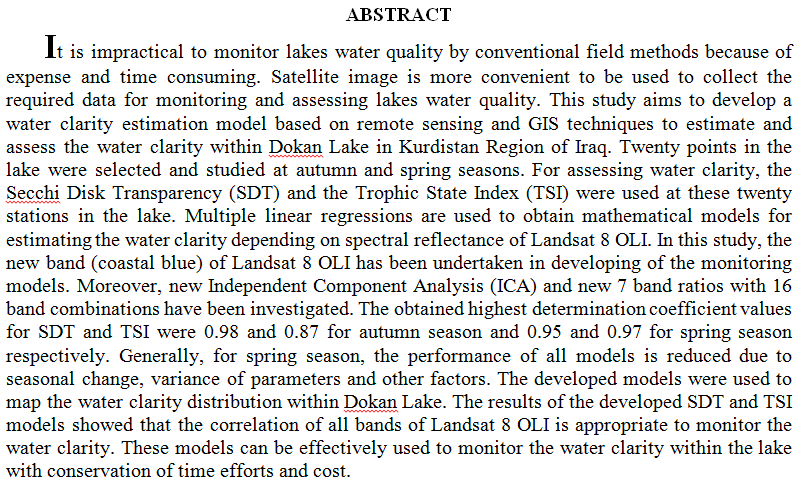
With its rapid spread, the coronavirus infection shocked the world and had a huge effect on billions of peoples' lives. The problem is to find a safe method to diagnose the infections with fewer casualties. It has been shown that X-Ray images are an important method for the identification, quantification, and monitoring of diseases. Deep learning algorithms can be utilized to help analyze potentially huge numbers of X-Ray examinations. This research conducted a retrospective multi-test analysis system to detect suspicious COVID-19 performance, and use of chest X-Ray features to assess the progress of the illness in each patient, resulting in a "corona score." where the results were satisfactory compared to the benchmarked techniques. T
... Show More (8)
(8)
 (2)
(2)
Vegetation monitoring is considered an important application in remote sensing task due to variation of vegetation types and their distribution. The vegetation concentration around the Earth is increase in 5% in 2000 according to NASA monitoring. This increase is due to the Indian vegetable programs. In this research, the vegetation monitoring in Baghdad city was done using Normalized Difference Vegetation Index (NDVI) for temporal Landsat satellite images (Landsat 5 TM& Landsat 8 OIL). These images had been used and utilize in different times during the period from 2000, 2010, 2015 & 2017. The outcomes of the study demonstrate that a change in the vegetation Cover (VC) in Baghdad city. (NDVI) generally shows a
... Show More (12)
(12)
 (7)
(7)
 (7)
(7)
Water stress has a negative impact on the yield and growth of crops worldwide and consequently has a global impact on food security. Many biochemical changes occur in plants as a response to water stress, such as activation of antioxidant systems. Molybdenum (Mo) plays an important part in activating the expression of many enzymes, such as CAT, POD, and SOD, as well as increasing the proline content. Mo therefore supports the defence system in plants and plays an important role in the defence system of mung bean plants growing under water stress conditions. Four concentrations of Mo (0, 15, 30, and 45 mg·L−1) were applied to plants, using two approaches: (a) seed soaking and (b) foliar application. Mung bean plants were subject
... Show More (16)
(16)
 (12)
(12)
High-performance liquid chromatographic methods are used for the determination of water-soluble vitamins with UV-Vis. Detector. A reversed-phase high-performance liquid chromatographic has been developed for determination of water-soluble vitamins. Identification of compounds was achieved by comparing their retention times and UV spectra with those of standards solution. Separation was performed on a C18 column, using an isocratic 30% (v/v) acetonitril in dionozed water as mobile phase at pH 3.5 and flow rate 1.0m/min. The method provides low detection and quantification limits, good linearity in a large concentration interval and good precision. The detection limits ranged from 0.01 to 0.025µg/ml. The accuracy of the method was
... Show More (4)
(4)
An experiment was conducted in pots under field conditions during fall seasons of 2017 and 2018. This study aimed to improve a weak growth of seedlings under salt stress in sorghum. Three factors were studied. 1st factor was three cultivars (Inqath, Rabeh, and Buhoth70). 2nd factor was seed priming (primed and unprimed seed). Seed were primed by soaking for 12 hours in a solution containing 300 + 70 mg L−1 of gibberellic (GA3) and salicylic (SA) acids, respectively. 3rd factor was irrigation with saline water (6, 9 and 12 dS m−1) resulting from dissolving sodium chloride in distilled water in addition to control treatment (distilled water). Randomized complete block design was used with four replications. In both seasons: the results sh
... Show More (28)
(28)
 (21)
(21)
Water samples from a variety of sources in Kelantan, Malaysia (lakes, ponds, rivers, ditches, fish farms, and sewage) were screened for the presence of bacteriophages infecting
 (11)
(11)
 (8)
(8)
 (1)
(1)
 (1)
(1)
A field experiment was conducted in Yusufiya sub-district - Mahmudiya township/Baghdad governorate in silty loam texture soil during the spring season of 2020. The experiment included three treatments with three replicates, as the Randomized Complete Block Design (RCBD) was used according to the arrangement of the split design block. The treatments are in the irrigation system, which included surface drip irrigation (T1) and sprinkler irrigation (T2). Secondly, the Irrigation levels including the irrigation using 0.70 Pan Evaporation Fraction PEF (I1), irrigation using 1.00 PEF (I2), and irrigation using 1.30 PEF (I3). Coupled with, Pota
... Show More (1)
(1)
 (1)
(1)
